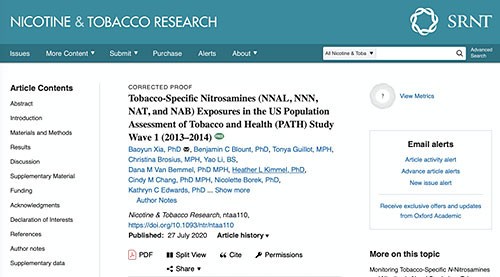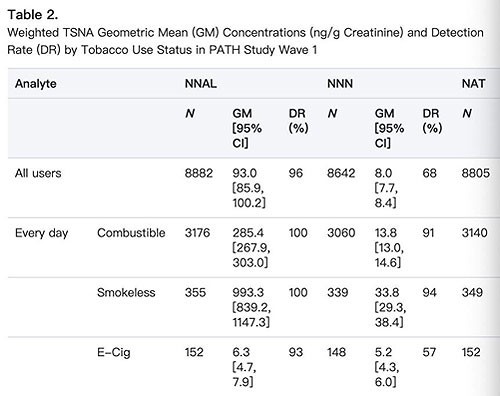On July 27, the latest paper released by researchers from the Centers for Disease Control and Prevention (CDC) showed that e-cigarette users have extremely low levels of the tobacco-specific nitrosamine (TSNA) metabolite NNAL in their urine, only cigarette users' 2.2% is 0.6% of smokeless tobacco users (snuff, chewing tobacco, etc.).

More than 70 carcinogens have been identified in traditional tobacco and second-hand smoke. Among them, tobacco-specific nitrosamines (TSNA) are the most important carcinogens in tobacco and the smoke produced by combustion, which are extremely harmful to the health of smokers and second-hand smokers. Big. TSNA includes NNK, NNN, NAB, NAT, etc. The World Health Organization (WHO) has determined that NNK and NNN are the main factors causing the carcinogenicity of cigarette smoke.
The study lasted for 7 years. Since 2013, it has collected epidemiological data on tobacco use behavior, including use methods, attitudes, habits, and health effects, and used this to evaluate the US Food and Drug Administration (FDA) related tobacco regulatory policies Impact. This paper is the result of the first phase of the study. It mainly monitors the urine NNAL concentration of experimenters in the first wave (W1) of the PATH study conducted from September 12, 2013 to December 15, 2014.
NNAL is a metabolite produced by the human body processing nitrosamines (TSNAs), which is excreted in urine. People inhale nitrosamines (TSNA) through the use of tobacco products or secondhand smoke, and then excrete the metabolite NNAL in the urine.
The results of the study showed that the average urine NNAL concentration of smokeless tobacco users was 993.3 ng/g creatinine, cigarette users were 285.4 ng/g creatinine, and e-cigarette product users were 6.3 ng/g creatinine, which is the urine of e-cigarette users.

This study is not the first time that CDC has published evidence that e-cigarettes do not have the second-hand smoke problem of traditional tobacco. As early as 2014, CDC researchers published a research paper on VOCs (volatile organic compounds) in the smoke of traditional tobacco and e-cigarettes, which showed that the level of VOCs metabolites VOCMs in the urine of e-cigarette users is comparable to that of people who have never smoked. Similarly, the concentration of VOCMs in smokers is significantly higher than that of e-cigarette users, smokeless tobacco users, and people who have never smoked. VOCMs are metabolites produced by the human body processing VOCs and are excreted through urine.
VOCs (Volatile Organic Compounds) is a general term for organic compounds that are volatile under certain conditions. The commonly known harmful substances such as benzene, toluene and formaldehyde belong to the category of VOCs.
TSNA (Nitrosamines) and VOCs (Volatile Organic Compounds) are the two most important carcinogens in traditional tobacco second-hand smoke. The above research of CDC proves that electronic cigarettes do not have the same second-hand smoke problems as traditional tobacco. This also shows once again that conflating e-cigarettes with traditional tobacco, and even using the harm of traditional tobacco second-hand smoke as evidence that e-cigarettes are included in the category of indoor tobacco control, is lack of scientific basis and absurd.
Vapesourcing Opinion:
The research results once again prove that e-cigarettes are far less harmful than traditional tobacco, and e-cigarettes do not have the second-hand smoke problem of traditional tobacco.










































































comments